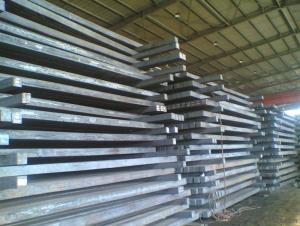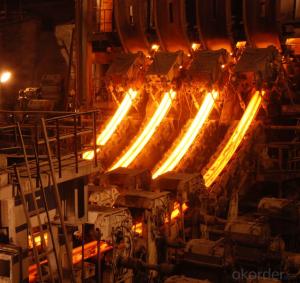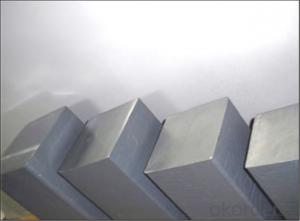Square Steel Billet Q235 3SP Grade Prime Quality 13#
- Loading Port:
- Tianjin
- Payment Terms:
- TT OR LC
- Min Order Qty:
- 2000 m.t
- Supply Capability:
- 50000 m.t/month
OKorder Service Pledge
OKorder Financial Service
You Might Also Like
Description of Square Steel Billet Q235 3SP Grade Prime Quality 13#
M. S. Billets are used for rolling of TMT Re-Bars of Fe415 and Fe500 Grade and various other structural steel products.
CRS Billets are used for rolling of CRS TMT Re-Bars.
Special Alloy Billets are used for rolling of any special grade TMT Re-Bars like Earthquake resistant TMT Re-Bars and for special grade structural steel products.
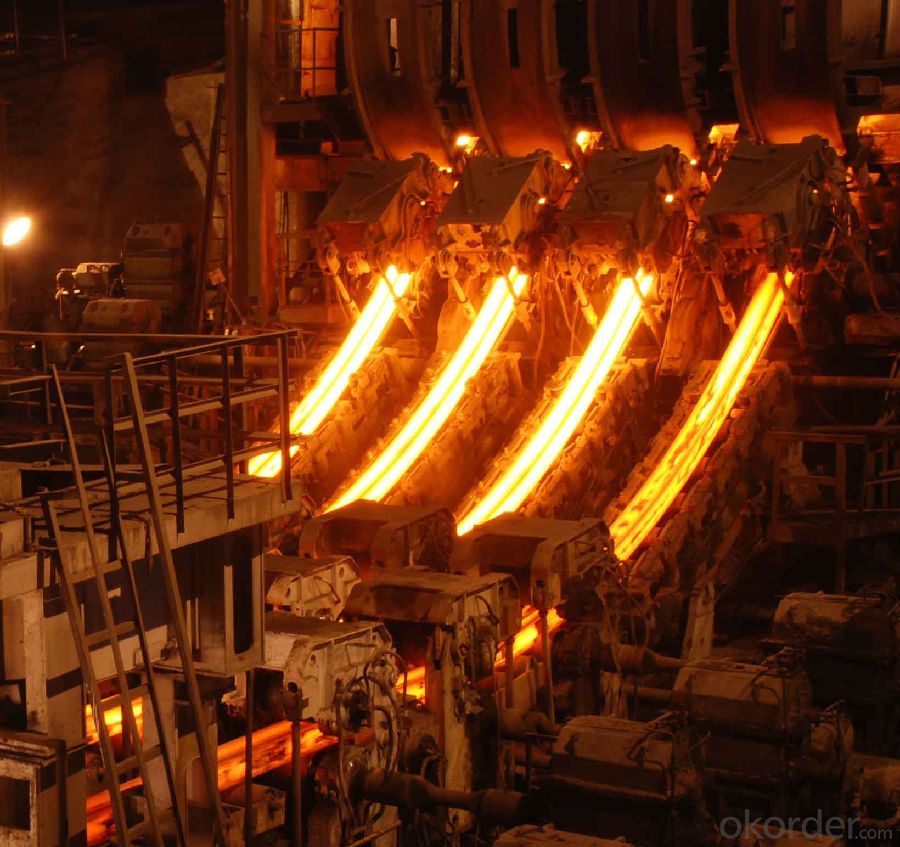
Main Feature Square Steel Billet Q235 3SP Grade Prime Quality 13#
Raw elements(C,Fe,Ni,Mn,Cr,Cu.)---Smelted ingots by AOD finery---hot rolled into black suface---pickling in acid liquid---cold drawn----polished by automatically machine--- cutting into pieces---checking quanlity
Applications of Square Steel Billet Q235 3SP Grade Prime Quality 13#
Widely Used in the areas such as Stainless Steel Fasteners, Chains, Kitchen and Sanitary wares, Furniture handles, Handrails, Electroplating and Electrolyzing pendants, Foods, Electron, Petroleum, Construction and Decoration, etc. Products have a high strength after cold-working. Electronic products parts, Medical appliance, Springs, Bus Inside and Outside packaging and building, Street Lamp Posts, etc. Decoration materials and Outdoor Publicity Billboard. Used for the products which have the Anti-Stress Corrosion requirement. Electron Products, Table-wares, Bolts, Nuts, Screen Meshes, Cumbustors and so on.
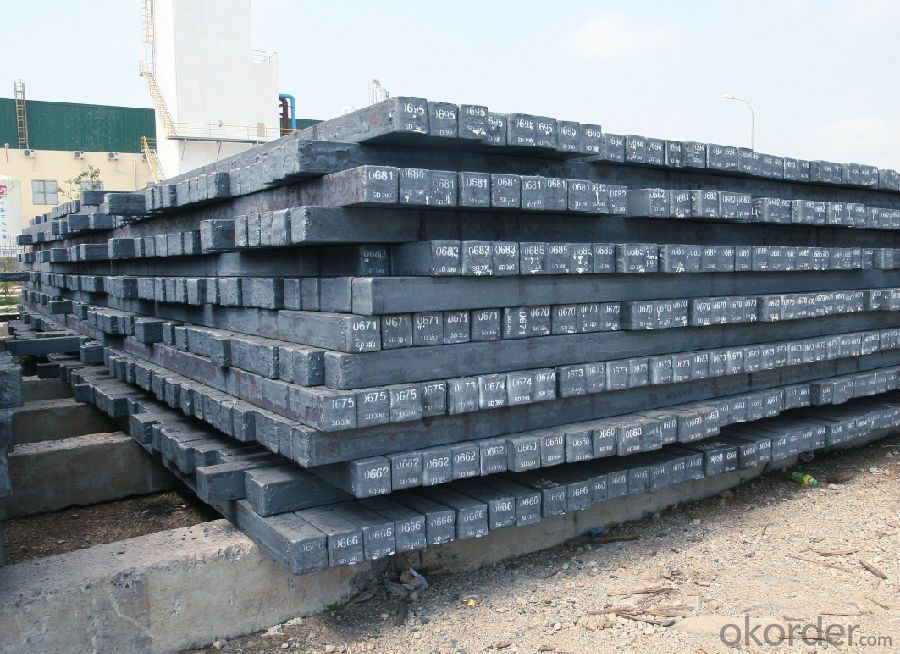
Specifications of Square Steel Billet Q235 3SP Grade Prime Quality 13#
| Standard | C(%) | Mn(%) | S(%) | P(%) | Si(%) |
| Q195 | ≤0.12 | ≤0.50 | ≤0.040 | ≤0.035 | ≤0.30 |
| Q235 | ≤0.20 | ≤1.40 | ≤0.045 | ≤0.045 | ≤0.35 |
| Q275 | ≤0.22 | ≤1.50 | ≤0.045 | ≤0.045 | ≤0.35 |
| 20MnSi | 0.17-0.25 | 1.2-1.6 | ≤ 0.050 | ≤ 0.050 | 0.40-0.80 |
| 3SP | 0.14-0.22 | 0.40-0.85 | ≤ 0.050 | ≤ 0.040 | 0.05-0.15 |
| 5SP | 0.28-0.37 | 0.50-1.00 | ≤ 0.050 | ≤ 0.040 | 0.15-0.30 |
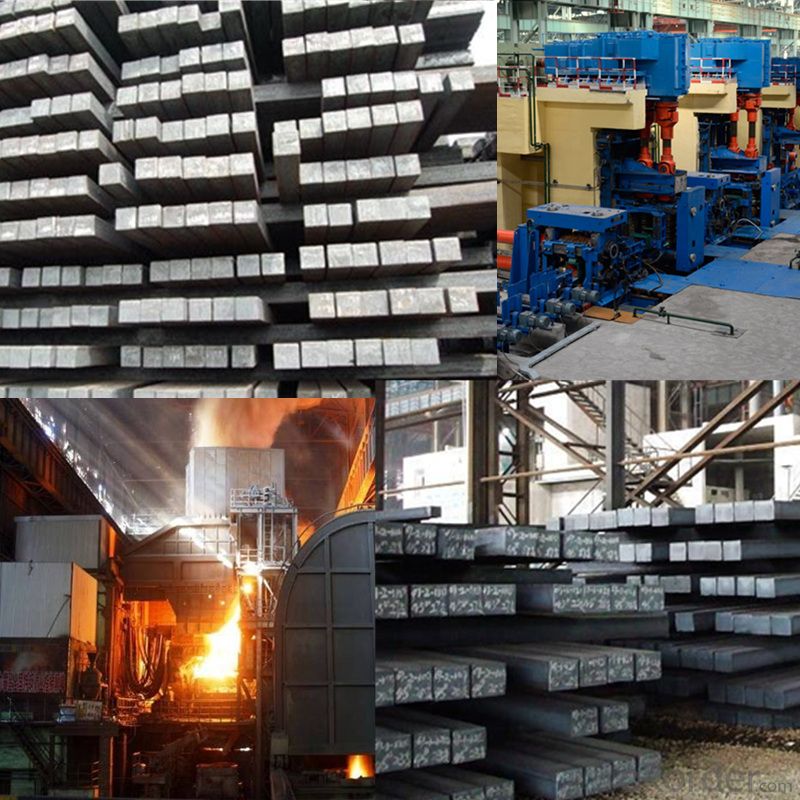
FAQ of Square Steel Billet Q235 3SP Grade Prime Quality 13#
We have organized several common questions for our clients,may help you sincerely:
1. How Can I Visit There?
Our company is located in Tianjin City, China, near Beijing. You can fly to Tianjin Airport Directly. All our clients, from home or aboard, are warmly welcome to visit us!
2. How Can I Get Some Sample?
We are honored to offer you sample.
3. Why choose CNBM?
Our delivery time about 15-20days for standard sizes, if you have other requirements like hardness, quanity and width ,it is about 20-40days. But don't worry we also try our best for the delivery time ,because time longer and our cost is higher.
- Q:How are steel billets recycled?
- Steel billets undergo the process of steel billet recycling, wherein they are collected from different sources like manufacturing plants, construction sites, and scrap yards. These collected billets are then transported to a recycling facility where they go through a series of steps to become new steel products. The initial step in steel billet recycling involves sorting and cleaning. The collected billets are sorted based on their size, shape, and quality, and any impurities or foreign materials are eliminated during this stage. Once the billets are sorted and cleaned, they are prepared for the next step in the recycling process. The subsequent step is melting, in which the cleaned steel billets are melted down in a furnace at extremely high temperatures. This melting process helps in separating any remaining impurities and enables the steel to be shaped into new forms. The molten steel is then poured into molds or cast into different shapes according to the desired end product. Once the steel has cooled and solidified, it undergoes further processing to achieve the desired specifications. This may include rolling, forging, or extruding the steel billets to create various steel products like bars, rods, or sheets. These newly formed steel products are then thoroughly inspected for quality and undergo rigorous testing to ensure they meet industry standards. The final step in steel billet recycling is distribution and usage. The recycled steel products are transported to various industries such as construction, automotive, or manufacturing, where they are utilized to create a wide range of products. By recycling steel billets, we can reduce the demand for raw materials, conserve energy, and minimize environmental impact. In conclusion, the process of steel billet recycling involves sorting, cleaning, melting, shaping, and distributing. This recycling process allows us to reuse steel billets and transform them into new steel products, thereby contributing to a more sustainable and environmentally friendly approach to steel production.
- Q:Can steel billets be used in the production of railway tracks?
- Yes, steel billets can be used in the production of railway tracks. Steel billets are commonly used as raw material for manufacturing various steel products, including railway tracks. The billets are first heated and then rolled into shape to create the required profile for the tracks. This process ensures the tracks have the necessary strength, durability, and dimensional accuracy to withstand the heavy loads and constant usage in railway operations.
- Q:What are the potential applications of steel billets in the medical industry?
- The medical industry offers a wide range of potential applications for steel billets. One possibility is their use in the manufacturing of surgical instruments. By shaping and machining the steel billets, they can be transformed into various surgical tools such as scalpels, forceps, and scissors. The strength and durability of steel make it an ideal material for these instruments, ensuring their longevity and reliability during surgical procedures. Another potential application for steel billets in the medical industry is the production of medical implants. Through processing and forming, the steel billets can be turned into implants like joint replacements, spinal implants, and dental implants. The biocompatibility of steel, along with its strength and resistance to corrosion, makes it a suitable material for implants that must withstand the body's environment and provide long-term support. Furthermore, steel billets can be utilized in the construction of medical equipment and machinery. Steel is commonly used in the manufacturing of medical beds, surgical tables, and imaging devices such as MRI machines and X-ray equipment. The structural integrity and stability of steel make it an excellent choice for these applications, ensuring the safety and functionality of medical equipment. Additionally, steel billets can be employed in the production of medical furniture and storage units. Medical facilities often use steel cabinets and shelves to store equipment, supplies, and medications. The strength and durability of steel guarantee that these storage solutions can withstand the demanding conditions of the healthcare environment. In conclusion, the potential applications of steel billets in the medical industry are extensive and varied. From surgical instruments and medical implants to equipment and furniture, steel possesses properties that enhance the quality and effectiveness of healthcare products and facilities.
- Q:What are the safety precautions when working with steel billets?
- To maintain a secure working environment and prevent accidents when dealing with steel billets, it is crucial to adhere to specific safety measures. Here are some essential precautions to bear in mind: 1. Personal Protective Equipment (PPE): Ensure that you wear the suitable PPE at all times, including steel-toed boots, safety goggles, gloves, and a hard hat. These items will shield you from potential hazards like falling objects, sparks, and sharp edges. 2. Training and Education: It is vital to provide comprehensive training and education to all workers regarding the handling and usage of steel billets. This encompasses understanding safe operating procedures, material handling techniques, and emergency response protocols. 3. Proper Handling and Storage: Mishandling steel billets can result in injuries due to their weight. Employ appropriate lifting techniques and equipment to prevent strains or sprains. Moreover, store the billets in designated areas, ensuring they are properly stacked and secured to avert accidents caused by falling objects. 4. Fire Safety Precautions: Moving or manipulating steel billets can generate sparks that could ignite flammable materials. Keep the work area clear of debris and flammable substances, and ensure that fire extinguishers are easily accessible. 5. Machine Safety: If utilizing machinery or equipment to handle steel billets, make certain that they undergo regular maintenance, have appropriate safeguards, and are operated by trained individuals. Adhere to all operational instructions and conduct routine safety checks to avoid accidents. 6. Sufficient Ventilation: Working with steel billets may generate fumes and dust, particularly during cutting or welding processes. Implement proper ventilation systems to eliminate these substances from the work area, minimizing the risk of respiratory issues. 7. Emergency Preparedness: Establish a well-defined emergency plan that outlines evacuation procedures, first aid facilities, and communication methods. Train all workers on emergency protocols and ensure they are aware of the locations of safety equipment and emergency exits. Always prioritize safety when working with steel billets. Adhering to these precautions will help minimize accident risks and foster a safe working environment for everyone involved.
- Q:What are the potential applications of steel billets in the automotive sector?
- The automotive sector benefits greatly from the versatility of steel billets. These billets play a vital role in producing automotive parts and components. They can be processed and shaped into rods, bars, and sheets to create essential components like engine parts, chassis, and suspension systems. The strength and durability of steel make it an ideal material for automotive applications. By transforming steel billets into high-strength steel alloys, we can harness their exceptional mechanical properties, including high tensile strength, hardness, and impact resistance. These properties are crucial for structural components like vehicle frames and bodies, providing stability and enhancing passenger safety. Engine parts such as crankshafts, camshafts, and connecting rods also benefit from the strength and resistance to wear and fatigue that steel billets offer. Gears, axles, and transmission components, which face demanding conditions in the automotive industry, require excellent mechanical properties that steel billets can provide. Steel billets are also instrumental in manufacturing suspension systems, including control arms, stabilizer bars, and springs. These components must withstand heavy loads, vibrations, and impacts while ensuring optimal ride comfort and handling. Steel billets' high strength and toughness make them well-suited for these critical suspension components. Moreover, steel billets find application in the production of safety features in automobiles. For instance, they can be used to manufacture reinforced door beams, which improve the vehicle's structural integrity and provide protection in the event of a collision. Seat frames and seatbelt components also benefit from the use of steel billets, ensuring passenger safety and restraint systems. In conclusion, the vast and essential applications of steel billets in the automotive sector cannot be overstated. Their strength, durability, and excellent mechanical properties make them indispensable for producing a wide range of automotive components, including engine parts, structural elements, and safety features.
- Q:How are steel billets tested for internal defects?
- Steel billets are tested for internal defects through a variety of non-destructive testing methods. One of the most common methods used is ultrasonic testing (UT). During this process, high-frequency sound waves are transmitted into the billet, and the reflections of these waves are analyzed to detect any internal defects such as cracks, voids, or inclusions. UT can provide accurate and detailed information about the size, location, and nature of the defects. Another method used is magnetic particle inspection (MPI). This technique involves magnetizing the billet and applying iron particles to its surface. If there are any internal defects, the magnetic field will cause these particles to gather around them, making them visible and detectable. Eddy current testing (ECT) is also employed to assess the internal quality of steel billets. It utilizes electromagnetic induction to create eddy currents within the material. Any changes in the electrical conductivity or magnetic permeability caused by internal defects can be detected by analyzing the variations in the induced current. Additionally, radiographic testing (RT) is utilized to inspect the internal structure of steel billets. X-rays or gamma rays are directed towards the billet, and the resulting radiographic image can reveal any internal defects such as voids, cracks, or inclusions. Other methods, such as dye penetrant testing and visual inspection, can also be used to detect superficial and near-surface defects in steel billets. These methods involve applying a liquid or dye to the surface of the billet, which will seep into any cracks or surface irregularities, making them visible under certain lighting conditions. Overall, a combination of these non-destructive testing methods is employed to ensure the quality and integrity of steel billets by effectively detecting any internal defects that could compromise their structural integrity and performance.
- Q:What are the main challenges in steel billet production?
- There are several main challenges in steel billet production that manufacturers and producers face. One of the key challenges is ensuring consistent and uniform quality of the billets. Steel billets are the semi-finished products that are further processed into various steel products, and any inconsistency or variation in their quality can lead to defects or failures in the final products. Therefore, maintaining strict quality control measures throughout the production process is crucial. Another significant challenge is optimizing the production process to meet the desired quantity and quality targets while minimizing costs. This involves efficient utilization of resources such as raw materials, energy, and labor. Additionally, maintaining a balance between the production speed and quality can be challenging as increasing the speed may lead to reduced quality or increased defects. Ensuring the safety of workers and the environment is also a major challenge in steel billet production. The production process involves heavy machinery, high temperatures, and potentially hazardous materials, which can pose risks to the workers' health and safety. Implementing proper safety protocols, providing training, and ensuring compliance with regulatory standards are essential to address these challenges. Furthermore, meeting the ever-increasing demand for steel billets is a challenge for producers. The market demand fluctuates, and manufacturers need to be able to adjust their production capacity accordingly. This requires flexibility in production planning and efficient inventory management to avoid overproduction or stock shortages. Lastly, technological advancements and innovations in the steel industry pose both challenges and opportunities. Adopting new technologies, such as automation, artificial intelligence, and data analytics, can improve efficiency and productivity. However, incorporating these technologies into existing production processes can be complex and require significant investments and expertise. In summary, the main challenges in steel billet production include maintaining consistent quality, optimizing production processes, ensuring safety, meeting market demand, and adapting to technological advancements. Overcoming these challenges requires continuous improvement, innovation, and a proactive approach to stay competitive in the steel industry.
- Q:What are the common sizes of steel billets used in construction?
- The common sizes of steel billets used in construction can vary depending on the specific project and requirements. However, there are several standard sizes that are commonly used in the construction industry. These sizes typically range from 100 mm (4 inches) to 200 mm (8 inches) in width and 100 mm (4 inches) to 300 mm (12 inches) in height. The length of the billets can also vary, but they are often around 6 meters (20 feet) long. These standard sizes are widely available and easily accessible, making them a popular choice for construction projects. However, it is important to note that the actual sizes of steel billets used in construction can be customized based on the specific needs and engineering requirements of a particular project.
- Q:What are the different methods of steel billet testing?
- Some of the different methods of steel billet testing include ultrasonic testing, magnetic particle testing, liquid penetrant testing, visual inspection, and hardness testing.
- Q:Can the production of continuous casting billet be damaged by using intermediate frequency electric furnace?
- No, as long as the quality of the billet is OK
1. Manufacturer Overview |
|
|---|---|
| Location | |
| Year Established | |
| Annual Output Value | |
| Main Markets | |
| Company Certifications | |
2. Manufacturer Certificates |
|
|---|---|
| a) Certification Name | |
| Range | |
| Reference | |
| Validity Period | |
3. Manufacturer Capability |
|
|---|---|
| a)Trade Capacity | |
| Nearest Port | |
| Export Percentage | |
| No.of Employees in Trade Department | |
| Language Spoken: | |
| b)Factory Information | |
| Factory Size: | |
| No. of Production Lines | |
| Contract Manufacturing | |
| Product Price Range | |
Send your message to us
Square Steel Billet Q235 3SP Grade Prime Quality 13#
- Loading Port:
- Tianjin
- Payment Terms:
- TT OR LC
- Min Order Qty:
- 2000 m.t
- Supply Capability:
- 50000 m.t/month
OKorder Service Pledge
OKorder Financial Service
Similar products
New products
Hot products
Hot Searches
Related keywords

